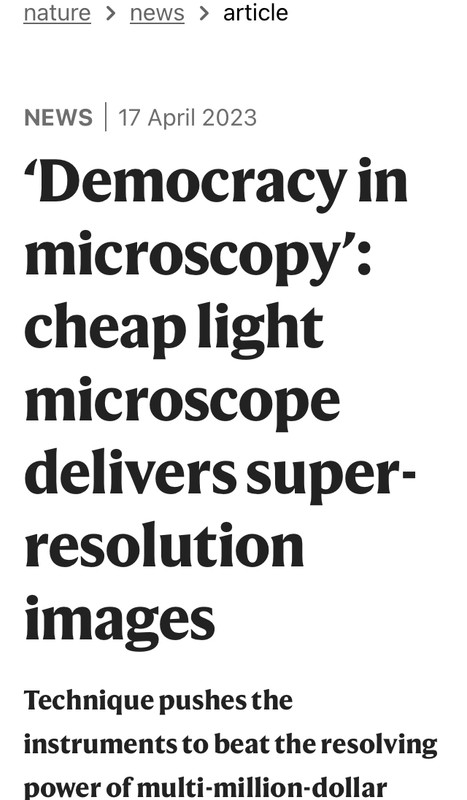冷冻电镜完了?
冷冻电镜完了?
物理学不存在了?廉价传统显微镜实现超高分辨率 细节水平超千万元显微镜
随心2023年04月19日 09:5316
受到光学定律的限制,传统光学显微镜只能观测200纳米以上的物体,再小的物体就会变得模糊。
而德国哥廷根大学医学中心纳米专家Ali Shaib和Silvio Rizzoli开发了一种用于普通光学显微镜的技术——ONE显微镜,可以让传统光学显微镜分辨1纳米以下的结构,足以看清单个蛋白质的形状。
据报道,ONE显微镜融合了此前已经存在并被使用的两种技术:一种技术是用光学技巧精确定位附着在蛋白质上的荧光分子(分辨率10纳米左右),另一种技术被称为膨胀显微镜的技术(分辨率20纳米左右)。
中国科学报表示,这项技术记录了单个蛋白质和从未见过的细胞结构的图像,其细节水平甚至超过了价值数百万美元的“超高分辨率”显微镜。
相关研究结果近日发表于预印本网站bioRxiv。Rizzoli表示:“显微镜技术也应该有某种形式的自由。该技术的高分辨率适用于很多人,而不是少数有钱的实验室。”
在此之前,科学家要用到冷冻电镜,或X射线结晶学方法对蛋白质进行成像。
据了解,如果想绘制出蛋白质最微小的部分,科学家通常只有两个选择:使数百万个单个蛋白质分子排列成晶体,然后用X射线晶体学分析它们;或者快速冷冻蛋白质的副本,然后用电子轰击它们,叫做冷冻电镜技术。
物理学不存在了?廉价传统显微镜实现超高分辨率 细节水平超千万元显微镜使用现有超高分辨率和扩展显微镜方法(从左至右1-3)以及ONE显微镜技术(4、5)产生的微管蛋白图像。
随心2023年04月19日 09:5316
受到光学定律的限制,传统光学显微镜只能观测200纳米以上的物体,再小的物体就会变得模糊。
而德国哥廷根大学医学中心纳米专家Ali Shaib和Silvio Rizzoli开发了一种用于普通光学显微镜的技术——ONE显微镜,可以让传统光学显微镜分辨1纳米以下的结构,足以看清单个蛋白质的形状。
据报道,ONE显微镜融合了此前已经存在并被使用的两种技术:一种技术是用光学技巧精确定位附着在蛋白质上的荧光分子(分辨率10纳米左右),另一种技术被称为膨胀显微镜的技术(分辨率20纳米左右)。
中国科学报表示,这项技术记录了单个蛋白质和从未见过的细胞结构的图像,其细节水平甚至超过了价值数百万美元的“超高分辨率”显微镜。
相关研究结果近日发表于预印本网站bioRxiv。Rizzoli表示:“显微镜技术也应该有某种形式的自由。该技术的高分辨率适用于很多人,而不是少数有钱的实验室。”
在此之前,科学家要用到冷冻电镜,或X射线结晶学方法对蛋白质进行成像。
据了解,如果想绘制出蛋白质最微小的部分,科学家通常只有两个选择:使数百万个单个蛋白质分子排列成晶体,然后用X射线晶体学分析它们;或者快速冷冻蛋白质的副本,然后用电子轰击它们,叫做冷冻电镜技术。
物理学不存在了?廉价传统显微镜实现超高分辨率 细节水平超千万元显微镜使用现有超高分辨率和扩展显微镜方法(从左至右1-3)以及ONE显微镜技术(4、5)产生的微管蛋白图像。
-
TheMatrix

- 论坛支柱

2024年度优秀版主
TheMatrix 的博客 - 帖子互动: 292
- 帖子: 13868
- 注册时间: 2022年 7月 26日 00:35
Re: 冷冻电镜完了?
我艹。真事啊:sdehc 写了: 2023年 4月 19日 11:37 物理学不存在了?廉价传统显微镜实现超高分辨率 细节水平超千万元显微镜
随心2023年04月19日 09:5316
受到光学定律的限制,传统光学显微镜只能观测200纳米以上的物体,再小的物体就会变得模糊。
而德国哥廷根大学医学中心纳米专家Ali Shaib和Silvio Rizzoli开发了一种用于普通光学显微镜的技术——ONE显微镜,可以让传统光学显微镜分辨1纳米以下的结构,足以看清单个蛋白质的形状。
据报道,ONE显微镜融合了此前已经存在并被使用的两种技术:一种技术是用光学技巧精确定位附着在蛋白质上的荧光分子(分辨率10纳米左右),另一种技术被称为膨胀显微镜的技术(分辨率20纳米左右)。
中国科学报表示,这项技术记录了单个蛋白质和从未见过的细胞结构的图像,其细节水平甚至超过了价值数百万美元的“超高分辨率”显微镜。
相关研究结果近日发表于预印本网站bioRxiv。Rizzoli表示:“显微镜技术也应该有某种形式的自由。该技术的高分辨率适用于很多人,而不是少数有钱的实验室。”
在此之前,科学家要用到冷冻电镜,或X射线结晶学方法对蛋白质进行成像。
据了解,如果想绘制出蛋白质最微小的部分,科学家通常只有两个选择:使数百万个单个蛋白质分子排列成晶体,然后用X射线晶体学分析它们;或者快速冷冻蛋白质的副本,然后用电子轰击它们,叫做冷冻电镜技术。
物理学不存在了?廉价传统显微镜实现超高分辨率 细节水平超千万元显微镜使用现有超高分辨率和扩展显微镜方法(从左至右1-3)以及ONE显微镜技术(4、5)产生的微管蛋白图像。

-
TheMatrix

- 论坛支柱

2024年度优秀版主
TheMatrix 的博客 - 帖子互动: 292
- 帖子: 13868
- 注册时间: 2022年 7月 26日 00:35
-
TheMatrix

- 论坛支柱

2024年度优秀版主
TheMatrix 的博客 - 帖子互动: 292
- 帖子: 13868
- 注册时间: 2022年 7月 26日 00:35
Re: 冷冻电镜完了?
是这么说的:
The power of conventional light microscopes is limited by the laws of optics, which mean that objects smaller than about 200 nanometres are a blur. Researchers have developed physics-beating super-resolution methods that, Rizzoli says, can bring this limit down to around 10 nm. The approach, which earned the 2014 Nobel Prize in Chemistry, uses optical tricks to pinpoint fluorescent molecules attached to proteins.
In 2015, researchers came up with another way to evade optical limits. A team led by Edward Boyden, a neuroengineer at the Massachusetts Institute of Technology in Cambridge, showed2 that inflating tissue — using an absorbent compound found in nappies — moves cellular objects away from each other. This technique, called expansion microscopy, led to leaps in microscope resolution and can resolve structures of around 20 nm.
Shaib and Rizzoli’s technique — described in a study posted to the bioRxiv preprint server last month — melds the two approaches to achieve resolutions below 1 nm. That is sharp enough to reveal the shape of individual proteins, which are typically imaged in finer detail using much more expensive structural-biology methods such as cryo-electron microscopy (cryo-EM) or X-ray crystallography.
Re: 冷冻电镜完了?
这说得清楚,新发展是把两个技术弄在一起。TheMatrix 写了: 2023年 4月 19日 15:28 是这么说的:
The power of conventional light microscopes is limited by the laws of optics, which mean that objects smaller than about 200 nanometres are a blur. Researchers have developed physics-beating super-resolution methods that, Rizzoli says, can bring this limit down to around 10 nm. The approach, which earned the 2014 Nobel Prize in Chemistry, uses optical tricks to pinpoint fluorescent molecules attached to proteins.
In 2015, researchers came up with another way to evade optical limits. A team led by Edward Boyden, a neuroengineer at the Massachusetts Institute of Technology in Cambridge, showed2 that inflating tissue — using an absorbent compound found in nappies — moves cellular objects away from each other. This technique, called expansion microscopy, led to leaps in microscope resolution and can resolve structures of around 20 nm.
Shaib and Rizzoli’s technique — described in a study posted to the bioRxiv preprint server last month — melds the two approaches to achieve resolutions below 1 nm. That is sharp enough to reveal the shape of individual proteins, which are typically imaged in finer detail using much more expensive structural-biology methods such as cryo-electron microscopy (cryo-EM) or X-ray crystallography.
-
huangchong(净坛使者)

- 论坛元老

2023-24年度优秀版主 - 帖子互动: 4187
- 帖子: 61760
- 注册时间: 2022年 7月 22日 01:22

